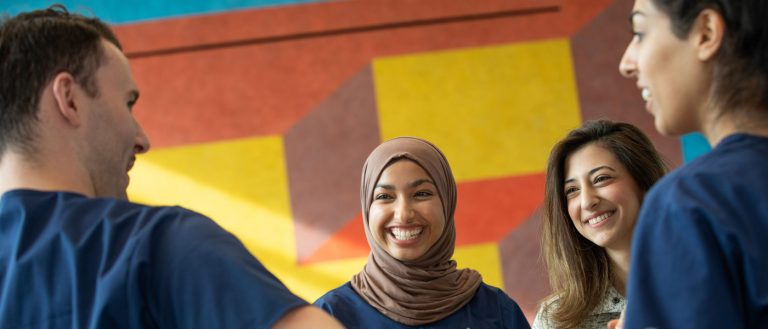A new course brings students from across the university together to help local organizations thrive
From its start, the Health Education Campus of Case Western Reserve University and Cleveland Clinic has been envisioned as a space to unite future health care professionals to improve interprofessional teamwork and, ultimately, patient care.
Since the summer 2019 opening of the campus, which includes the Sheila and Eric Samson Pavilion and Dental Clinic, Case Western Reserve’s health profession students have learned alongside each other during events, joint classes, shared study spaces and more.
And starting last fall, interprofessional education became formalized through a new course: Collaborative Practice I. The yearlong class connects students from Case Western Reserve’s dental, medicine, nursing and social work schools, as well as programs in the College of Arts and Sciences, to learn teamwork skills and collaborate on projects that support Cleveland-area agencies and organizations.
“The best way for students to learn how to work in a team is to work on a team,” explained Tyler Reimschisel, MD, the university’s founding associate provost for interprofessional education, research and collaborative practice. “In other words, we don’t just want to teach them teamwork skills in the classroom. We want them to have the opportunity to apply what we are teaching as they work on a real project.”
About 440 students are taking the course, which meets weekly via Zoom during the pandemic. They split time between their community-based projects and classroom education—learning teamwork and other relevant skills, such as project management, systems theory and leading change. Plus, they regularly tackle topics important to their projects and their professions, such as mitigating implicit bias, understanding how history has perpetuated health disparities, and discussing values and ethics across professions, Reimschisel explained. Faculty coach and assess the teams along the way, focusing not just on their project outcomes but how they worked together to succeed.
Calculating collaboration
440 students in the Collaborative Practice class 5-7 students per team
72 student teams
59 projects being worked on for
40 local agencies and organizations
The projects are as varied as the organizations they benefit. For example, students are creating an after-school tutoring and wellness program in Cleveland’s Hough neighborhood; improving outreach to LGBTQ individuals facing barriers to access health care; creating education and engagement opportunities to reduce infant mortality rates, especially among Black babies; and developing training for local seniors to keep them connected via technology during the pandemic.
“These projects are authentic and meaningful for the organization, so the deliverable will make an impact if they are successfully completed,” Reimschisel said. “Thus, the students’ time is being applied to an important task, not just a mere assignment for a class.”
Each project has a “champion” from the community organization or agency who serves as a liaison to the Office of Interprofessional Education, Research and Collaborative Practice. University faculty and staff provided the champions with professional development opportunities to prepare them for the experience, and continue to offer monthly workshops throughout the year to identify best practices, address questions and make iterative improvements.
These enhancements will be especially important come fall, as the program expands to include 100 undergraduate nursing students and bring on even more projects to help community partners.
Through this course, said David Rolf II, DMD, the dental school’s associate dean of academic affairs, “our students will develop their professional identity, learn about their own roles on the health care team, deliver valuable services through service learning, and strengthen their professionalism.”
This article originally appeared in the School of Dental Medicine’s winter/spring 2021 magazine. View the full publication (PDF).

